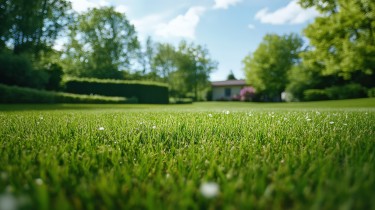

Discover the Secret to a Lush and Healthy Lawn
Read More ›
Blog
Follow these simple tips for a healthier, greener lawn

If you’re looking to have the “perfect” lawn — one that gives your neighbors a serious case of “lawn envy” — then you’re going to want to add dethatching, aeration, and overseeding to your lawn maintenance schedule.
But these three jobs can be time-consuming and technical if you’ve never cared for a lawn before. So, for all you DIYers out there, here’s a crash course on what our crews do to get that perfect lawn for our customers.
The best way to get that dark, green golf-course color you crave is to loosen the soil by aerating your lawn and allowing it to breathe.
Aerating your soil on a consistent basis will extend the life of your grass by encouraging deep root growth. It also:
For best results, I’d recommend using a plug aerator. A spike aerator just pokes holes in your lawn and is less effective than removing a plug of grass and soil —and actually compacts the soil further.
Aeration should be done mid-August to mid-October to increase root growth, help your lawn to breathe and minimize thatch build-up in the spring. The plugs should be 2–3 inches deep, 0.5–0.75 inches in diameter, and about 2–3 inches apart.

Winter weather, aging grass, pets, and pests can take a toll on your lawn, leaving it thin, bare, and full of weeds.
Getting into the habit of regularly overseeding your lawn can keep it looking like a thick, green carpet.
Here are a few tips to follow when overseeding your lawn:
Overseeding your lawn does more than just keep it looking green and lush. It keeps grass strong and healthy —which helps with erosion —reduces risk from pests and disease, and minimizes the need for dangerous chemicals.

If your grass is looking weak and pale, it’s more than likely heavy thatch (dead grass) has built up over your soil, leaving it gasping for air.
Some thatch is okay — but more than an inch can cause problems for your lawn by trapping water and keeping oxygen and nutrients from reaching the roots. (Note: if you aerate your lawn regularly, you likely won't need to dethatch. Brandon Rushing doesn't offerer dethatching services because our aeration services prevent the need for detaching!)
Thatch can also be a breeding ground for insects and disease-causing organisms.
The only way to remove excessive thatch is by vigorous raking with a good, stiff rake —and plenty of elbow grease!
You may have to use muscles you don’t often use, so here are a few tips to save your hands, arms, shoulders, and back:
It’s a good idea to incorporate dethatching as a regular part of your late-summer/fall cleanup.
By following the tips above you can have a lawn you’re proud of. But we understand not everyone has the time —or desire —to do it themselves.
As always, the team at Brandon Rushing is happy to help. See our lawn care programs or get a free quote with our online pricing tool.
Written by Brandon Rushing, Founder & President
Posted on: July 7th, 2021